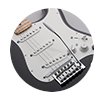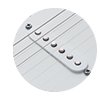Crazy Train was the first single released from the 1980 Ozzy Osbourne debut solo album Blizzard of Ozz. The classically trained axe-slinger that blazed through the solo was none other than the legendary Randy Rhoads.
Contributed by Josh Munday – Tone Designer
Recommended Article: 4 Elements of Guitar Tone
For Crazy Train, Randy Rhoads used his Jackson guitar through a Marshall Super Lead 100 watt head and cabinet. Rumour has it that the solo was so loud, Randy couldn’t be in the same room as the amp without hemorrhaging some internal organs!
They recorded his amp in a stone room downstairs at the Ridge Farm Studios in England while Randy sat in the control room away from the blistering volume.
They used 3 mics on the speakers, 1 ‘on’ the amp and 2 others at different distances from the cabs that really add character to the tone and have a big influence on how to replicate his sound which I’ll explain in the effects section below.
Let’s get started…
Since I used the BOSS ME-80 on my Classic Patches Medley video, I’m going to go through how I approached the ‘Crazy Train’ tone on it here, but essentially the process would be same on any of the BOSS multi effects units.
In an earlier blog article, I spoke about the best way to approach a guitar tone is to consider the 4 Elements of Guitar Tone and using those principles, we have:
1. The Guitar
Jackson Guitar with 2 Humbuckers
2. The Pickup Selection
This is a bridge pickup tone which we can tell by the brightness of the sound, so select the bridge pickup. If you don’t own a guitar with a humbucker in the bridge position, go for the closest approximation on your guitar. e.g. on a 3-single coil guitar like a strat (which I’m using in the clip), select the bridge pickup and we can deal with the tonal differences later in the EQ, Compressor and FX sections.
3. The Amp
Always start with everything off – I can’t stress this enough! Find the OFF button for everything in the signal chain so all you can hear is your dry guitar sound coming through. Remember any multi-FX / amp simulator like the BOSS ME-80 is simulating a room full of gear. So, think about it like that – you wouldn’t walk into a room full of amps and FX and start by turning everything ON would you? You would plug into an amp, get a good basic tone, then turn on any effects one at a time and build up your sound…. likewise with any multi-FX.
When selecting an amp there are some basic rules of thumb that will help:
- Set the EQ ‘flat’ (i.e. all settings at the half way point or 12 o’clock) as this gives you a neutral starting point so that the EQ isn’t colouring the tone.
- Set the gain at about a quarter of a turn (9 o’clock).
By now you should have a good idea of what the plain amp tone sounds like with a mild amount of gain, so you can hear the gain stage character.
Taking it further
Randy Rhoads used a Marshall Super Lead 100 watt head on ‘Crazy Train’, with 2 x 412 Quad Boxes running VERY loud! Although we could use the STACK setting I found that the DRIVE setting for the amp was closer to the tone from the album. This tone has a real top end ‘buzziness’ to it so I’ve selected the “Drive” amp setting and cranked the EQ settings quite high. The settings I’ve used are BASS on 72, MIDDLE on 89 and TREBLE on 86.
I’ve only put the GAIN up to 40 because much of the gain on this tone came from a distortion pedal. If you run too much gain on the amp and then run a distortion pedals gain as well it will give us too much compression and we’ll lose clarity in the sound.

4. The Effects
In this section we’ll cover how to modify the pickup tone to allow for whatever guitar you are working with. This is also the section where we simulate the room mic effect from that recording.
I’ve used a strat so I have a single coil in the bridge and as I mentioned earlier this is more of a humbucker like tone so I’ve use the ‘Single-Hum’ converter feature in the COMP/FX1 section of the ME-80 to thicken up the tone.
The gain for the solo is from a combination of amp gain and pedal gain. I’ve used a BLUES setting in the OD/DS Section of the ME-80 and turned up the DRIVE to 40, the TONE to 73 (to try and get more of the ‘buzziness’ in the tone).
And finally…
Then the final (and one of the most crucial) parts of this tone is the sound of the room mics on the Amp. Often there’ll be a mic ‘on’ the amp (meaning up close) and then a mic located in the room somewhere. In this case there were 3 mics used. The first mic is ‘on’ the speaker, the second is 3 foot from the speaker and the third is 12 feet away. We can simulate a room mic with a single short delay with each millisecond of delay representing 1 foot of distance between the amp and the room mic.
In this case the amp sound itself represent the mic ‘on’ the speaker. The second mic i’ve represented using a MODULATE setting on the DELAY setion. Turn on the delay and put it on MODULATE, put the repeats to ‘0’ (which actually means 1 single repeat), turn the Effect Level up to about 66% in this case and then adjust the settings up to 30.
You can hear that this changes the tone of the amp sound. And can give a slightly ‘metallic’ tone to it (if you play a note while you do turn this up you’ll hear the tonal change that goes on when you add this in).
One last mic…
The last room mic is further away and has a ‘slap back’ effect. For this I’ve used the second DELAY in the EQ/FX2 section of the ME-80. Select DELAY and put the time to 80 and the LEVEL to 66. This gives us a close approximation to the most distant room mic effect in the recording.
There’s also a small amount of reverb on this sound too so I’ve selected a ROOM Reverb and turned it up to about 15.
There you have it guys, that is how I got the ‘Crazy Train’ guitar tone that you can hear in the video.
FREE Crazy Train Patch Downloads
BOSS GT-100 HERE
ME-80 HERE
GT-001 HERE
Thanks to Mark Smith for his assistance in writing this article.
Others in the series:
BOSS ME-80 Classic Patches Medley
Brian May’s ‘Killer Queen’ Guitar Tone Dissected
‘Another Brick In The Wall – Part II’ (Pink Floyd) Guitar Tone Dissected
‘Panama’ (Van Halen) Guitar Tone Dissected
‘Hotel California’ (The Eagles) Guitar Tone Dissected
‘Bad to the Bone’ (George Thorogood) Guitar Tone Dissected
‘Crazy Train’ (Ozzy Osbourne) Guitar Tone Dissected
‘Killing In The Name’ (Rage Against The Machine) Guitar Tone Dissected
Click on Product Page ME-80
Hands-On Access to a World of Great Tones
Click on Product Page GT-100
Version 2.0: Full Power for Stage and Studio
Click on Product Page GT-001
Flagship GT Power on Your Desktop
Image: alphaspirit, Tasnadi Erika / 123RF







